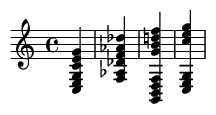Summary:
The Neapolitan chord, a striking chromatic harmony, adds a unique splash of color and emotion to music. This article demystifies this special chord, exploring its definition as a major triad on the lowered supertonic, its primary function as a pre-dominant chord, its historical context, and its practical application in composition. Learn how to build, identify, and use the Neapolitan chord to create powerful and expressive harmonic progressions.
Keywords:
Neapolitan chord, Neapolitan sixth, chromatic harmony, major chord, pre-dominant function, voice leading, bII chord, harmonic analysis, music theory, composition, classical music, romantic music
Introduction:
In the world of harmony, some chords simply stand out. The Neapolitan chord is one of them. It's a chromatic "guest" chord that brings a distinctive, often poignant or dramatic, flavor to a piece of music. While it appears most frequently in works from the Baroque, Classical, and Romantic eras, its powerful sound makes it a valuable tool for composers in any genre. Understanding how to use the Neapolitan chord is a key step in mastering the art of chromatic harmony and elevating your compositional and analytical skills.
Definition and Function:
The Neapolitan chord is a major triad built on the lowered supertonic (the second scale degree, lowered by a half step). It is most commonly designated with a capital "N" or as "bII".
- In a minor key: In C minor, the supertonic is D. The lowered supertonic is Db. The Neapolitan chord is a Db major triad (Db-F-Ab).
- In a major key: In C major, the supertonic is D. The lowered supertonic is Db. The Neapolitan chord is also a Db major triad (Db-F-Ab).
While it can appear in root position, the Neapolitan is most famous for its use in first inversion. This is why it is frequently called the "Neapolitan Sixth" (N⁶ or bII⁶), referring to the interval of a sixth above the bass note. Its primary function is as a pre-dominant harmony, meaning it creates a strong pull towards the dominant (V) chord, setting up a powerful resolution.
Examples in Notation:
Example 1: The Neapolitan Sixth in a Minor Key
This is the most common context for the Neapolitan. Here is a typical progression in C minor: i – N⁶ – V – i. Notice how the Db in the N⁶ chord creates a smooth melodic line leading to the B in the V chord.

Example 2: The Neapolitan in a Major Key
Though less common, the Neapolitan is also highly effective in a major key, providing a moment of dark, rich color. Here is a progression in C major: I – N⁶ – V⁷ – I.

Practical Applications and Voice Leading:
The defining feature of the Neapolitan's sound comes from its voice leading into the dominant. The lowered supertonic (the root of the N chord) has a powerful tendency to resolve downwards to the leading tone (the third of the V chord). In the key of C (major or minor), this is the melodic motion from Db down to B. This leap of a diminished third is highly characteristic and is what gives the progression its intense, dramatic quality.
One of the most famous examples is in the first movement of Beethoven's "Moonlight" Sonata (Piano Sonata No. 14 in C# minor). In the third measure, Beethoven introduces a D major chord in first inversion (with an F# in the bass). Since the key is C# minor, D major is the Neapolitan chord (bII). Its unexpected brightness in the dark minor key creates a moment of breathtaking beauty and sorrow.
Historical Figures:
The Neapolitan chord became a staple of the common practice period (roughly 1650-1900). It was used with great effect by Baroque composers like Alessandro Scarlatti and the "Neapolitan School" of opera composers, from which the chord derives its name. Later, Classical composers like Mozart and Haydn used it for dramatic emphasis, and it became a favorite expressive device for Romantic composers like Beethoven, Schubert, and Chopin, who used it to heighten emotional intensity.
Fun Facts:
The name "Neapolitan" is a bit of a geographical misnomer. While it was used by composers from Naples, Italy, its use was widespread across Europe and not exclusive to the Neapolitan style. Its characteristic sound, often described as "yearning," "tragic," or "intensely emotional," makes it an instantly recognizable and memorable harmonic device. It is a perfect example of how a single chromatic chord can fundamentally alter the emotional landscape of a piece of music.
Conclusions:
The Neapolitan chord is far more than a theoretical curiosity; it is a powerful tool for musical expression. By understanding its construction as a major triad on the lowered supertonic (bII), its function as a pre-dominant, and its characteristic voice leading, you can unlock a new level of harmonic depth in your analysis and composition. Listen for it in the works of the great masters and experiment with it in your own writing. Can you find another famous piece of music that uses the Neapolitan chord?
References:
Kostka, S., & Payne, D. (2007). Tonal Harmony: With an Introduction to Twentieth-Century Music. McGraw-Hill.
Schoenberg, A. (1978). Theory of Harmony. University of California Press.
Aldwell, E., & Schachter, C. (2011). Harmony and Voice Leading. Schirmer.
